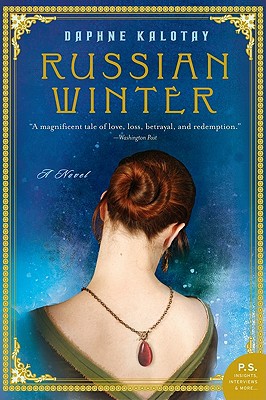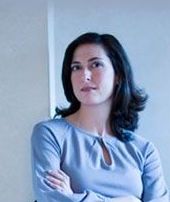Book Review: A Cinematic Russian Winter (Updated)
Russian Winter is part mystery and part love story, drawing on the (overly) familiar tropes of each: the missing jewels, the deceived lovers, and so on. The material is not original, but it is workable and proffers plenty of Hollywood glamor.
Russian Winter by Daphne Kalotay. Harper Perennial, 496 pages, $14.99.
By Nora Delany
It is the year of Swan Lake, of ballerinas called Nina. The same year Darren Aronofsky’s Oscar-nominated film Black Swan swooped in, debut novelist Daphne Kalotay published Russian Winter. The parallels are odd: apparently we like our ballerinas to have delicate fussy names like Nina; and when we think ballet, we think Swan Lake with Tchaikovsky’s haunting, powerful music and a simple iconic story of deception, loss, and love. Kalotay’s story works with and mimics Swan Lake in much the same way as Aronofsky’s film does, and, in Russian Winter, Kalotay’s Nina (like Aronofsky’s) is both duped victim and vengeful offender, sweet Odette and treacherous Odile.
We first meet Nina Revskaya as an old woman in her Boston apartment, preparing to auction off the precious collection of jewelry she has accumulated over the years and has brought with her from Europe. When she was young, Nina danced with Moscow’s Bolshoi Ballet and acquired a reputation as a star ballerina, nicknamed “Butterfly.” Not many years into her career, however, Nina defects from the USSR to France, Britain, and then America, while her husband Viktor Elsin, a well-known Russian poet, ends up in the gulag. When Nina auctions off her jewelry decades later in Boston, she is forced to face episodes from her past that she would rather forget.
Kalotay begins her story with an auction lot description of a piece of jewelry—the first of many that are interleaved in the novel between sections that constantly shift in focus from present-day Boston to 1950s Moscow—from old, arthritic Nina in a wheelchair to young, spry Nina dancing in the Bolshoi Theater and back. The rapid cuts back and forth build a temporally-jumbled narrative, drawing in more characters from Nina’s past and present. The effect interrupts the reader’s momentum; we only follow one thread for so long before we are wrenched back into the past or to another character’s perspective.
And so the mystery begins: in Boston, a middle-aged professor Grigori Solodin owns an amber necklace, earrings, and a bracelet that match those in Nina’s collection; his own past is somehow linked to Nina’s, but she refuses to talk to him. It is only through revisiting Nina’s past, traveling across time and continents in Kalotay’s choppy narrative, that we can put the pieces together. Slowly, Grigori discovers more about his own past and his connection to the Butterfly. Along the way, he develops a tentative relationship with the auction house associate, Drew Brooks, who is working on Nina’s auction.
Russian Winter is part mystery and part love story, drawing on the (overly) familiar tropes of each: the missing jewels, the deceived lovers, and so on. The material is not original, but it is workable and proffers plenty of Hollywood glamor. I was put in mind, in particular, of James Cameron’s 1997 film Titanic. The film starts with Rose Dewitt as an old woman fingering a necklace given to her decades earlier on that doomed ship. The piece of jewelry connects her to her own young womanhood in another place and time, to her youthful love story, and to tragedy.
Nina Revskaya’s jewels, in particular the amber suite around which the mystery turns, serve the same purpose as Rose’s necklace in Titanic: they recall a lost lover and a past self; they demonstrate what remains, tangibly, through hardship and tragedy. The glitz and glamor of the ballet and the jewelry together with the story of lost love are made for the screen.
Even if it is familiar material, Russian Winter is—after a slow start—a good yarn with enough of a hook to keep you reading. And it is evident that Kalotay did her homework; the jeweler’s terminology is convincing as are the details of life in Soviet Russia. A quick glance at the author’s afterword on sources at the back of the book reveal that Kalotay steeped herself in Benjamin Zucker’s Gems and Jewels: A Connoisseur’s Guide and Victoria Finlay’s Jewels: A Secret History, as well as memoirs, letters, and oral histories by Soviet defectors and former Bolshoi ballerinas. The research pays off, especially in the parts of the novel that focus on Nina’s youth—the drab Moscow apartment blocks and bitter poverty that make that compelling and cinematic contrast with the glamor of the stage and greasepaint.
The intensity of Kalotay’s Russia, however, makes the Boston scenes flat and pale in comparison. Each time I find myself in elderly Nina’s Back Bay apartment, I wish to be—as the Beatles’ song goes—back in the USSR where the real danger and passion of the story reside. The two worlds—1950s Moscow and 2000s Boston—are irreparably far, despite the connections made in the novel and the way in which Kalotay draws the lives of Grigori, Drew, and Nina together in the end.
As in Aronofsky’s film, Swan Lake is the binding motif. In the Bolshoi Theater, it was this ballet that made Nina a star, and it is during a performance of Swan Lake in Berlin that Nina escapes to freedom. The theme of the good and evil twins, Odette and Odile, surfaces in Nina’s relationship with her childhood friend Vera—a central figure in Kalotay’s story of loss and love. The images and themes in Kalotay’s work are very familiar: the dance, the music, those stock figures of long-necked dancers, jewels, betrayal, and love. But Kalotay’s novel serves up an entertainingly cinematic reading experience.
After reading Russian Winter, Nora Delany had a few questions for its author, Daphne Kalotay.
Arts Fuse: The characters’ lives are connected in a complex and intriguing manner; do you see your novel as a mystery story as well as a love story?
Daphne Kalotay: At first I didn’t think of it as either of those things; having only published stories, I was overwhelmed by the simple fact of writing a novel and just wanted to tell a story about these people—artists, scholars, writers—trying to create lives for themselves in difficult circumstances.
But I did think of my book as similar, in certain ways, to A. S. Byatt’s Possession, which I consider a literary mystery. The problem was that I don’t read “mystery” novels, per se, so I didn’t know how to set one up or how to solve it—which in retrospect I think was good for me, since it meant I had to figure things out as I went along. The more important thing that I learned, I think, is that many kinds of books have an element of mystery (some hook that keeps you reading) and that this is something a writer should consciously cultivate.
Meanwhile, the parallel love stories became very important to me as I wrote, so that now I see my novel very much as a love story, although I didn’t originally conceive of it that way.
AF: With its ambiguous ending, do you consider the mystery solved at the end or left open?
Daphne Kalotay: I actually don’t consider the ending ambiguous, since in general the reader is given enough information to make an educated assumption. n terms of Grigori’s parentage, we can guess the answer to that question and be pretty sure we’re right, even if Grigori himself will never have absolute, concrete proof. But that open-endedness, and being comfortable with it, is part of the lesson Grigori has to learn.
AF: It must have been fun doing research for this novel. How did you work with your sources (the books on jewels and gems; the memoirs), and how did these sources shape your novel?
Daphne Kalotay: In terms of research, since my foremost goal was to capture the overall reality of life in Soviet Russia, much of my reading was devoted to cultural/social histories. The key, for me, was to never just read but to always keep moving forward in the writing. Otherwise it would be easy to just do research forever and never write a word. I would read in bursts—history books, then individual accounts, then back to scholarly texts—and jot down any details I found especially compelling. My reading affected the storyline at times, in that I would consider possibilities for scenes or plot points based on things I’d read (while at the same time sometimes later discovering things I’d “made up” appearing in actual people’s accounts.) In this way, I gained a sense of authority about the subject matter.
For my ballet research, where I wanted to get a good sense of backstage life, I didn’t just read but also spoke to some dancers, in order to get the nitty gritty details and make sure I had things right. Much of that research came later, when I went back to fill in parts of the story that needed more ballet background. I wanted the novel to feel as richly detailed and authentic as possible.
I read only a few books on jewels and gems, but I went to jewelry auctions and spoke to a jewelry specialist in order to make sure that none of the information I included was wildly off. The strongest influence on the plot was the fact that, once I became interested in the auction house world, I realized that the climax of the book should be an auction scene, and that something quite dramatic had to happen there. So I knew, then, what I was writing toward, and had to figure out how to make it happen.
AF: You draw together two very different worlds — 1950s Soviet Russia and 2000s Boston. Tell me a bit about the process of moving between the two places in your novel.
Daphne Kalotay: At first the transitions between these two time periods were very awkward. I thought I had to signal to the reader each time I was about to shift back to Nina’s past, so I would have Nina offer the Drew character tea—as if she were about to take a break and tell her story—and then move into a flashback. Finally a friend read a draft and said, Enough with the tea. It was too corny, not to mention repetitive.
What I had to learn was that, yes, the reader might find the first couple of leaps back in time and then forward again jarring—but after that, it would probably begin to feel natural. And indeed, as I wrote, these shifts back and forth began to have their own rhythm, like tides going in and out, and I found myself knowing intuitively when and how to make those shifts.




